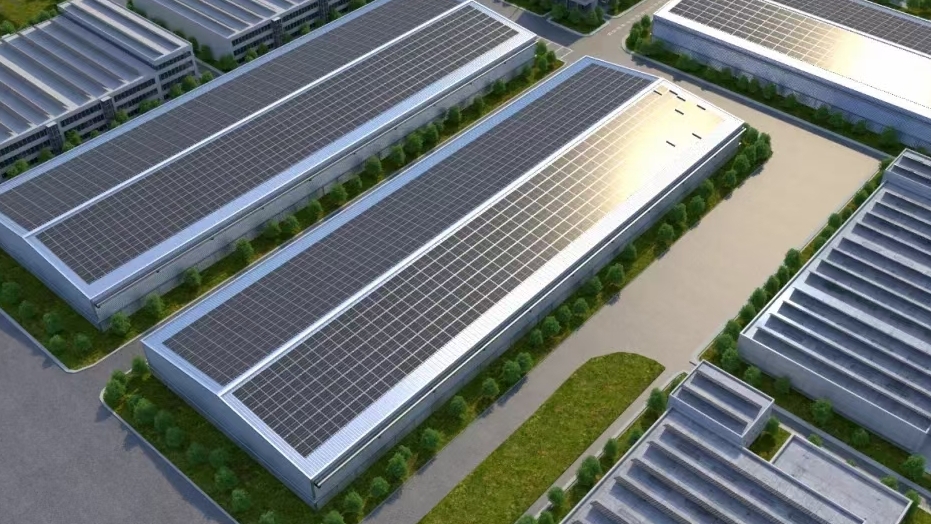有什么類型屋頂不能安裝呢?
一、屋頂結(jié)構(gòu)與承重問題
1、 Roof structure and load-bearing issues
屋頂?shù)慕Y(jié)構(gòu)和承重能力是決定光伏項目可行性的關(guān)鍵因素。工商業(yè)建筑常見的屋頂類型包括平屋頂、斜屋頂、彩鋼瓦屋頂?shù)龋糠N類型都有其特點和安裝要求。
The structure and load-bearing capacity of the roof are key factors determining the feasibility of a photovoltaic project. The common types of roofs in industrial and commercial buildings include flat roofs, sloping roofs, color steel tile roofs, etc. Each type has its own characteristics and installation requirements.
1. 彩鋼瓦屋頂:這類屋頂承重能力相對較弱,通常只能承受10-20kg的荷載。如果需要安裝光伏系統(tǒng),必須進行詳細的承重計算和加固。
1. Color steel tile roof: This type of roof has relatively weak load-bearing capacity and can usually only withstand a load of 10-20kg. If a photovoltaic system needs to be installed, detailed load-bearing calculations and reinforcement must be carried out.
2. 混凝土屋頂:承重能力較強,但安裝光伏系統(tǒng)時仍需考慮額外荷載對建筑整體結(jié)構(gòu)的影響。
2. Concrete roof: It has strong load-bearing capacity, but when installing photovoltaic systems, the impact of additional loads on the overall structure of the building still needs to be considered.
屋頂承重是工商業(yè)光伏項目中最易被忽視的問題之一。因此,在項目啟動前,必須進行專業(yè)的屋頂承重評估。
Roof load-bearing capacity is one of the most easily overlooked issues in industrial and commercial photovoltaic projects. Therefore, a professional roof load-bearing assessment must be conducted before the project starts.
二、屋頂材質(zhì)與老化問題
2、 Roof material and aging issues
屋頂?shù)牟馁|(zhì)和老化程度直接影響光伏系統(tǒng)的壽命和安全性。常見的屋頂材質(zhì)包括彩鋼瓦、混凝土、瀝青瓦等。其中,彩鋼瓦因其輕質(zhì)、耐腐蝕、易安裝等特點,在工商業(yè)光伏項目中得到廣泛應(yīng)用。然而,彩鋼瓦的耐久性相對較差,易受風雨侵蝕和溫度變化影響,導致變形、銹蝕等問題。
The material and aging degree of the roof directly affect the lifespan and safety of the photovoltaic system. Common roof materials include color steel tiles, concrete, asphalt tiles, etc. Among them, color steel tiles are widely used in industrial and commercial photovoltaic projects due to their lightweight, corrosion-resistant, and easy installation characteristics. However, the durability of color steel tiles is relatively poor, and they are susceptible to wind and rain erosion and temperature changes, leading to deformation, corrosion, and other problems.

混凝土屋頂則具有較高的承重能力和耐久性,但安裝光伏時需注意避免破壞屋頂?shù)姆浪畬雍捅貙印r青瓦屋頂則因材質(zhì)較軟,安裝光伏時需特別小心,以免損壞瓦片。
Concrete roofs have high load-bearing capacity and durability, but when installing photovoltaics, attention should be paid to avoiding damaging the waterproof and insulation layers of the roof. Asphalt tile roofs, on the other hand, require special care when installing photovoltaics due to their soft material to avoid damaging the tiles.
1. 材質(zhì)問題:部分老舊廠房的屋頂材質(zhì)可能因腐蝕、破損而無法滿足光伏系統(tǒng)安裝要求。
1. Material issue: The roof material of some old factories may not meet the installation requirements of photovoltaic systems due to corrosion and damage.
2. 老化風險:老化嚴重的屋頂可能在光伏系統(tǒng)運行期間出現(xiàn)漏水、結(jié)構(gòu)松動等問題,影響系統(tǒng)穩(wěn)定性和建筑安全性。例如,裂縫可能導致雨水滲入光伏系統(tǒng)內(nèi)部,引發(fā)短路、火災(zāi)等安全隱患;脫落的瓦片則可能砸傷光伏板,影響其發(fā)電效率。
2. Aging risk: Roofs with severe aging may experience problems such as water leakage and structural looseness during the operation of the photovoltaic system, affecting system stability and building safety. For example, cracks may cause rainwater to seep into the interior of photovoltaic systems, leading to safety hazards such as short circuits and fires; Dropping tiles may damage photovoltaic panels and affect their power generation efficiency.
三、陰影遮擋與朝向問題
3、 Shadow occlusion and orientation issues
光伏系統(tǒng)的發(fā)電效率高度依賴于陽光直射時間。陰影遮擋和朝向不當會顯著降低發(fā)電量。然而,在實際應(yīng)用中,屋頂上的煙囪、天窗、空調(diào)外機等障礙物往往會遮擋部分陽光,導致光伏板發(fā)電效率降低。
The power generation efficiency of photovoltaic systems is highly dependent on the duration of direct sunlight exposure. Shadow occlusion and improper orientation can significantly reduce power generation. However, in practical applications, obstacles such as chimneys, skylights, and outdoor air conditioning units on rooftops often block some sunlight, leading to a decrease in the efficiency of photovoltaic panel power generation.
此外,周邊建筑物、樹木等也會對光伏系統(tǒng)產(chǎn)生遮擋影響。若遮擋嚴重,可能導致光伏系統(tǒng)無法正常工作,甚至引發(fā)安全隱患。因此,在選擇屋頂安裝光伏時,需對周邊環(huán)境進行詳細勘查和評估,確保光伏板能夠充分接收陽光照射。
In addition, surrounding buildings, trees, etc. can also have a blocking effect on the photovoltaic system. If the obstruction is severe, it may cause the photovoltaic system to malfunction and even pose a safety hazard. Therefore, when choosing to install photovoltaic panels on rooftops, it is necessary to conduct a detailed investigation and evaluation of the surrounding environment to ensure that the photovoltaic panels can fully receive sunlight.
傾角的選擇也至關(guān)重要。傾角過大或過小都會影響光伏板的發(fā)電效率。一般來說,傾角應(yīng)與當?shù)鼐暥认嘟蚵源笥诰暥戎怠H欢趯嶋H應(yīng)用中,還需考慮屋頂?shù)钠露取⒅苓吔ㄖ锏母叨鹊纫蛩兀源_定最佳的傾角值。
The choice of inclination angle is also crucial. Excessive or insufficient tilt angle can affect the power generation efficiency of photovoltaic panels. Generally speaking, the inclination angle should be close to or slightly greater than the local latitude value. However, in practical applications, factors such as the slope of the roof and the height of surrounding buildings need to be considered to determine the optimal tilt angle value.
四、法律法規(guī)與審批問題
4、 Legal regulations and approval issues
工商業(yè)光伏項目的建設(shè)必須嚴格遵守國家和地方的法律法規(guī)。例如,《可再生能源法》、《電力法》等法律法規(guī)對光伏項目的建設(shè)、運營等方面提出明確要求。
The construction of commercial photovoltaic projects must strictly comply with national and local laws and regulations. For example, laws and regulations such as the Renewable Energy Law and the Electricity Law provide clear requirements for the construction and operation of photovoltaic projects.
本文由工商業(yè)屋頂光伏情奉獻.更多有關(guān)的知識請點擊:http://m.51dwgw.cn我們將會對您提出的疑問進行詳細的解答,歡迎您登錄網(wǎng)站留言.
This article is a friendly contribution from distributed photovoltaic power generation For more information, please click: http://m.51dwgw.cn We will provide detailed answers to your questions. You are welcome to log in to our website and leave a message
新聞推薦
product recommendation聯(lián)系方式
Contact Information

 TEL:0531-82390078
TEL:0531-82390078 TEL:18805312017
TEL:18805312017 MAI:sdzdny001@163.com
MAI:sdzdny001@163.com 公司地址: 濟南市歷下區(qū)山大路157號
公司地址: 濟南市歷下區(qū)山大路157號 天合藍天·山東種電
天合藍天·山東種電 備案號:魯ICP備17052940號-2
魯公網(wǎng)安備37010202700164號
備案號:魯ICP備17052940號-2
魯公網(wǎng)安備37010202700164號
 網(wǎng)站地圖|XML|TXT
網(wǎng)站地圖|XML|TXT

掃一掃方便咨詢我們

截屏,微信識別二維碼
微信號:18805312017